Hill Farm
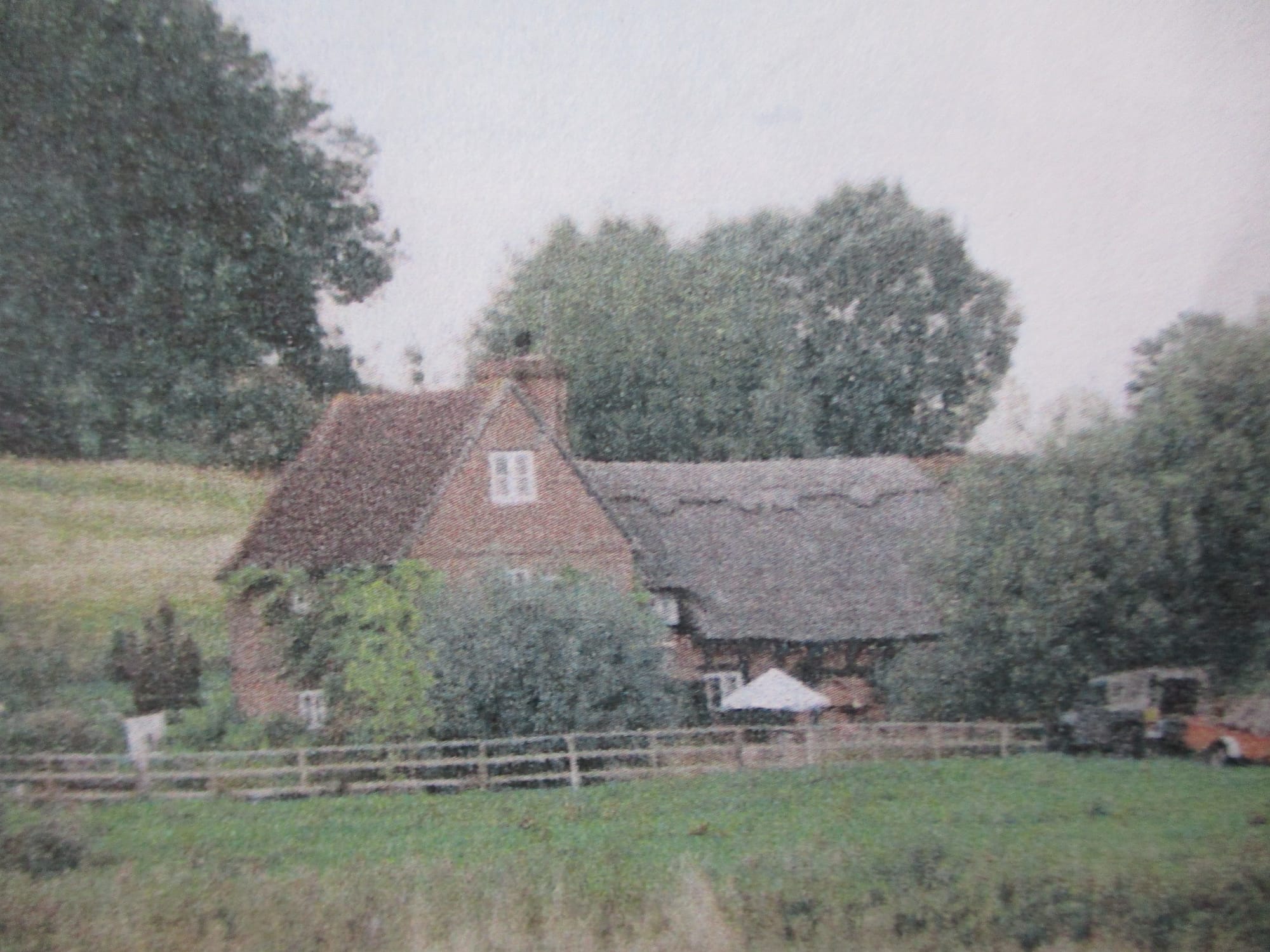
Apparently a dwelling on this site was recorded in the Domesday book as a shepherds cottage. Part of the house dates back to Henry VII but it has been added to at various stages over the centuries.
At the time of the 1806 Inclosure Act where Hill Farm can be found today appears to have been largely Plot No 24 with a piece of Plot No 21 but was likely included in Plot No 22, identified as the Homestead. It was 2 rods, 20 perches, in size and was owned by William Butt. The buildings shown at Plot No 20, house, barn and cottage, are no longer there but I believe was known as Snowes Messuage, was also then owned by William Butt, is recorded elsewhere on this website, and survived into the twentieth century.
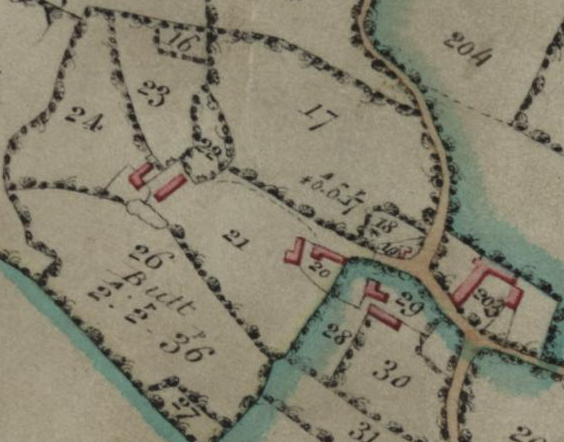
In 1829 Edward Webb, then of Adwell, Oxon, bought Hill Farm from Samuel Butt. On 25 March 1829 it appears that Samuel Butt leased the farm back for a period of 12 years at £580 per annum.
In 1838 this was No 38, known as The Hill, and was cottages and gardens owned by Edward Webb of the Norton Court Estate and let to Henry Simmons and Thomas Merriman.
The Simmons family owned several properties and some land around this area. Henry was likely the son of William and Elizabeth Simmons who were living where Fir Tree Cottage now stands at this time. Henry was born at Norton in 1798, married Emily Trinder at Sandhurst in 1820, and in 1841 was an agricultural labourer living with his wife and two sons. Thomas Merriman was living with his wife Mary and two adult children at what was already named ‘Hill Farm’.
In 1851 Henry Simmons was living in the household of his son Charles, his wife and daughter, ‘near Norton House’. Thomas Merriman is still in this area in 1851 but it’s not clear exactly where he was living. He was then 75 years old, an agricultural labourer and pauper originally from Elmstone Hardwicke. There is also a Henry Mann, 50 year old agricultural labourer, living with his wife Eliza, daughter and George Moulder, an agricultural labourer who was lodging with them.
The 1860s weren’t a good decade for those living at or near Hill Farm. Henry Simmons was still at Norton living with his wife and young granddaughter in 1861 but he died in September 1863. Wife Emily died whilst living at Gloucester in March 1866 but was returned to Norton for burial at St Mary’s. Thomas Merriman died in the Gloucester Union Workhouse in January 1866.
Norton Court Estate papers from 1861 record that two cottages and gardens were still here at that time, Plot No 37 on the following plan, 1 rod, 13 perches in size and in the occupation of Henry Mann.
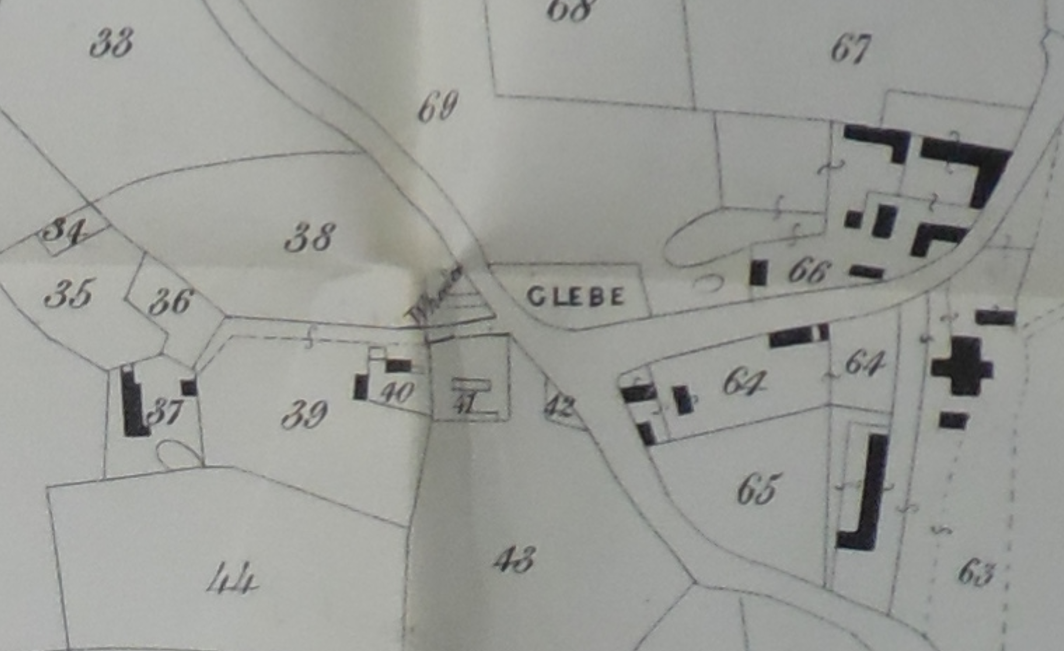
Henry Mann was living with his wife Eliza and had another lodger in 1861 but died in 1868. Henry’s widow Eliza remained at Norton until she died in 1873 but it is not clear where she resided.
In April 1868, a declaration by Mr Bruton with respect to Land Tax of the Norton Court Estate, records that William Turk was at Hill Farm on a yearly tenancy paying £10-0s-0d. This would have been William, son of William and Elizabeth Turk born at Norton in 1832. The family appear to have lived near Cold Elm when William jnr was growing up and he followed his father into the trade of chairmaking. William married Ann Perkins, also of Norton, at Cheltenham in 1857 and may have come to Hill Farm straight after marriage. Hill Farm was in Plot No 65 and was described as a cottage and garden.
The next time Hill Farm can be positively identified is in 1891 when William Turk, then a 55 year old cabinet maker, is still living here with his wife Ann and daughter in law, Lizzie. It is likely that the Turks had been here throughout. William died in May 1891 and by 1901 widow Ann had left Norton and was living with her married son Charles at Edwy Parade, Gloucester, where she died in 1909.
In 1897 Charles Ellis is qualified to vote due to land and tenement at Hill Farm, Norton, where he was living. Charles was a pig dealer and had been at Norton, likely Hill Farm, since 1894 presumably when Ann Turk left.
In 1898-99 Harry Crump was here briefly.
Between 1900 and 1904 a William Mann appears on Norton’s electoral roll occupying land and a tenement at Hill Farm. There had been Manns at Norton for several hundred years and a William Mann living near The Green at Norton for many years prior to this and he may be the same person although he may also never have been in residence at Hill Farm. It was a John Mann, maybe a relation of William, and his family who were here.
John was born at Hartpury in 1850, the son of Jeremiah Mann, a labourer, and Harriet/Ann nee Blackwell. John married Deborah Ford at Hartpury on 20 June 1874 and in 1881 they were living at Moorend, Hartpury, with three young children and John employed as an agricultural carter. By 1891 they had moved to Park Gate, Redmarley, where the family had extended to ten children and John was still a carter and Deborah was working as a laundress. John appears to have arrived at Norton in 1900 and in 1901 was farming at Hill Farm with Deborah still working as a laundress and eleven children and a grandson also in residence. In April 1905 we find an administration order made in Gloucester County Court against John Mann, a carter of Wainlode Hill, Norton. John owed £45 7s 3½d and had offered to repay 7s 6d in the pound at a rate of 6s per month. He stated that he had had fourteen children and that eight of them were still at home and depending upon him. In 1908 John and Deborah Mann paid £24 10s for Norton Court Estate Ladyday rent.
In 1911 there were two families living at Hill Farm. Whilst John Mann and family continued to farm here, with only four children left at home, they were living in five rooms downstairs, whilst Fred and Janet Pollock were renting three furnished rooms from them on the first and second floors.
Frederick George was born in January 1855, son of Archibald Reid Swiney, Indian Civil Service, and Janet Justina Pollock, and was baptised on 14 February 1855 at Benares, Bengal, India. In 1861 Frederick had come to England and was living in the house of his widowed grandfather, John Davidson, a retired surgeon who had also served in India, at 1 Gloucester Crescent, Paddington, London. Two of Frederick’s siblings, five other grandchildren and one of John’s daughters, all born in India, were also in residence along with a number of servants. By 1871 Frederick’s mother had returned to England and was living with nine children, including Frederick, at 6 St Michaels Place, Brighton. On 9 August 1873 Frederick was commissioned as Sub-Lieutenant in the Kings Own Yorkshire Light Infantry (51st Light Infantry) and returned to serve in India. He took part in the Jowaki Expedition in the North West Frontier in 1877, receiving the medal and clasp. He also served in the Afghan War, 1878-80, taking part in the affair at Baghao as well as the Hissarak and Lughman Valley Expeditions for which he also received medals. In 1880 he transferred to the Bengal Staff Corps and on 1 August 1887, he married Jane Hamilton at Pachmari, Bengal. Jane had been born in 1856 at Julundin, India. In 1892 Frederick was a Captain in the Indian Army, was promoted to Lieutenant Colonel in August 1901 and retired in April 1902. Whilst at Hill Farm in 1911, Frederick was recorded as a retired Colonel and was still on the strength of the Indian Army as a Lieutenant Colonel, Bengal Staff Corps, in 1912. Frederick died at Hill Farm on 18 September 1914 and this likely ended the family’s time at Norton. By 1921 widowed Jane was living with a widowed sister at 4 Ashling Villas, Cheltenham, where she was still living when she died in 1923. Jane actually died on 28 October at 11 Vista Alegre, Rio Tinto, Huelva, Spain, but was interred with her husband in the family vault at St Peters, Leckhampton.
John and Deborah Mann were still at Hill Farm in 1915 but must have left around this time.
In 1918 James Henry and Georgina Batty were the only residents recorded at Hill Farm. James Henry was born on 19 April 1862 at Carrhills Mill, Saddleworth, Yorks, son of Henry Haigh Batty(e), a railway signal and points man, and Mary Ann nee Wryothwell. In 1871 the family were living at Saddleworth with 9 year old James already employed as a cotton carder. In 1881 the family were living at New Earth Cottages, Roughtown, Mossley, Saddleworth, with James employed as a cotton stripper and grinder. On 1 March 1888 James’ father was killed when he was walking to work at his London North-Western Railway Company signal box at Mossley and was struck by a passenger train heading from Manchester to London. James married Georgianna Maria Susannah Flowers in 1891 at Stockport, Cheshire. Georgianna was born on 3 May 1865 at Hasfield, Glos, daughter of Charles Flowers, a groom, and Mary Ann nee Collins. In 1881 Georgianna was living with her parents in Gloucester employed as a dressmaker and her father was a hunt’s ostler employing two men. By the 1890s James and Georgianna were living at 478 Cheetham Hill, Lancs, where James had become a beer retailer. In 1901 they were living at 32 Worcester Street, Gloucester, where James was then an insurance agent and music teacher and wife Georgianna was employed as a wardrobe dealer; making and selling clothes. Wife Mary’s parents were living next door at No 34 where James and Mary were living in 1903. James appears to have done well with his music teaching over the coming years. In 1902 their daughter Florence passed the Trinity College London, Pianoforte playing, preparatory division examination, taught by her father.

Gloucester Citizen, 13 January 1903
In May 1903 James was appointed organist and choirmaster at Eastington parish church, near Stroud, and in December 1905 an organ and vocal recital was held in the church at The Leigh when it was reported that “the organ solos by Mr James Batty … deserves special mention”. In 1911 James, Georgianna and their three daughters; Florence Edith, Dorothy Winifred and Constance Mabel, were living at 6 Worcester Parade, Gloucester, with James still employed as a music teacher and Mary as a wardrobe dealer.

Cheltenham Chronicle and Gloucestershire Graphic, 4 September 1912
By 1918, if not slightly earlier, the family had come to Hill Farm and Georgianna was still here in 1920 but maybe not James. This is the last reference to the family at Norton with Georgianna moving to Wellcroft, The Leigh. In 1939 they may have been living apart with Georgianna still at The Leigh employed as a smallholder and James living in the household of the Price family back at 6 Worcester Parade, Gloucester, a retired store keeper. Georgianna died at The Leigh on 24 August 1941 and James in Gloucester in 1943.
The next resident at Hill Farm was Albert Ernest Groves. Albert had been born at Hereford on 17 May 1890, son of James and Catherine Groves who were at Brick House Farm, Up Hatherley, Cheltenham, in 1901 and Church Farm and Ivy House Farm, Priors Norton, between 1916 and 1922. Albert and had married Elizabeth Frances Walker at Gloucester in 1913 having a daughter, Betty, in 1919, whilst they were farming at Bredons Hardwick, Worcs. In 1920 they were at Hill Farm where Albert was a smallholder and in May 1920 Albert appeared at Gloucester Police Court where he was fined £3 for driving without lights. PC Hayward added that the “the defendant drove on when signalled to stop and cut at him with his whip”. The family must have left Hill Farm for Twigworth shortly afterwards and in February 1925 Albert was at the Gloucester County Petty Sessions for moving pigs without authority; “Albert Ernest Groves, a farmer of Brookfield, Twigworth, was summoned for removing 25 pigs from Brookfield, Twigworth, to Church Farm, Twigworth, before the expiration of 28 days after previous removal. He pleaded guilty” … “the defendant was granted a license to move 25 store pigs from Ledbury Market to Brookfield, Twigworth, and he later removed them from the latter place to Church Farm, Twigworth, without authority. The pigs should have remained at Brookfield for 28 days” … “A fine of 10s was imposed”. At the same time a receiving order was made at Gloucester County Court, at Albert Groves’ own petition, and he was adjudicated a bankrupt. In 1939 Albert, Elizabeth and Betty were living at ‘Aysgill’, Alcester Road, Stratford on Avon, where Albert was employed as a stockman and pig keeper. Albert died in 1975 and Elizabeth in 1982.
By 1924 Christopher and Blanche Davis were at Hill Farm with William Ryder also in residence so perhaps the property was still split in two. Christopher Harry Leach Davis was born on 21 October 1887 at 19 Magdala Terrace, Gloucester, son of William Samuel Davis, who was employed at Gloucester Wagon Works, and Sarah Jane Webb, a widow. The family were still at Magdala Terrace in 1891 when father William was a striker/smith on the Midland Railway. The family were living at Brookville Villa, India Road, Gloucester, when, on 27 July 1899, an inquest was held at the India House Inn, Barton Street, Gloucester, on Christopher’s mother’s death by suicide; “… husband of deceased, William Samuel Davis, a painter employed at the Wotton Asylum. Said that deceased was 47 years of age, and he was married to her about 12 years ago, she being then a widow. On Wednesday morning last he left home at about a quarter to six, leaving his wife and three children in bed. He returned for breakfast at 8,30, and his wife then seemed brighter and more ‘talkish’ than she had been for some time. At one o’clock, when he came home for dinner, he met his son Christopher, who said his mother had gone upstairs either to dust the room or to lie down. Witness went upstairs, and found the door of the bedroom locked. He shouted four times, and getting no answer he thought something was the matter, and forced the door open. He found his wife lying in a pool of blood with her throat cut, apparently quite dead. He then sent for a neighbour and for the police. Deceased had been suffering from rheumatism of the backbone, from which she suffered considerably. She had been away for three months for a change, staying with her mother near Stonehill, and came home on Monday evening last. He was not aware that she had any other trouble but her physical ailments”. The deceased, Sarah, had sent a letter to a brother and sister telling them that she was in agony, couldn’t take it anymore, and of her intentions asking for their forgiveness. The jury returned a verdict of ‘suicide whilst temporarily insane’”.
In 1901 the widowed William was living with his two sons at 47 India Road employed as a stationary engine driver at the lunatic asylum and son Christopher, aged just 13, as a collar and cuff stamper at a shirt factory. In 1911 Chistopher was living in the household of his married sister Rosa and her family at 37 Upton Street, Gloucester, employed as an engine fireman on the Midland Railway. Christopher married Blanche Witts at Sandhurst in 1916 having two children, Iris and John, and by 1921 they were living at 10 Upton Street, Gloucester, where Christopher was still a Midland Railway locomotive fireman based at the Barnwood Engine Shed. The family were at Hill Farm in 1924 but their time here must have been brief as by 1927 they were at 15 St Marks Street, Gloucester. In 1939 the family had moved again with Christopher and Blanche living at The Nook, Longford Lane, where Christopher was an engine driver for the London Midland and Scottish railway. Christopher died in 1961 and Blanche in 1962.
Following Christopher and Blanche Davis we have William Ryder who was at Hill Farm briefly with the Davis’ in 1924 and was still here in 1925 although it seems likely he was simply lodging here temporarily whilst doing a particular job for the Norton Court Estate as he actually had a family home elsewhere.
William James Ryder was born on 2 May 1885 at Quedgeley, Gloucester, son of James Wathen Ryder and Rosa Alberta nee Vick. Father James was a gardener and they were living at The Lodge, Quedgeley Court. By 1901 son William had taken employment as a timber sawyer. William was confirmed at Gloucester Cathedral in 1902 at which time they were living at 103 Tredworth Road, Gloucester. Having previously served with the 1st Gloucestershire Regiment Volunteers, on 23 August 1909, William enlisted at Gloucester for short service, 3 years in the colours with 9 years in reserve, as Private, No 14432, Grenadier Guards. On 8 July 1909 he had underwent a medical examination that found him to be 6ft 1ins tall, 156lbs in weight, 38ins chest, fresh complexion, brown eyes, dark brown hair, and had several tattoos on his forearms. Initially posted to Caterham, Surrey, in 1911 William was serving as a Private with the 1st Battalion, Grenadier Guards, posted to Wellington Barracks, Westminster, London. He was transferred to the reserve on 23 August 1912, service complete, but was mobilised on 5 August 1914 with the commencement of the First World War. William was serving with the 3rd Battalion, Grenadier Guards, when, on 13 July 1915, he was discharged ‘having been found no longer physically fit for war service’. The reason was given as ‘varix’ identified in London in August 1909 and not attributable to his military service but probably aggravated by it. He was given the Chelsea Hospital Outpatient No 130937 and granted a gratuity of £30. His character was assessed as ‘very good’ and he was awarded the Royal Victorian (Bronze) Medal (1910) and the King George V Coronation Medal (1911). William James Ryder married Margaret Annie Neville at St George Hanover Square, London, in 1912 and they were to have three children all born at Gloucester; Rosa, William and Philip. Margaret was born on 16 July 1889 at Wood Green, London, daughter of Charles W Neville, a carpenter, and in 1901 she was living with her widowed father and siblings at 15 Barclay Road, Walthamstow, London. In 1913 William and Margaret were living at 25 Linden Road, Gloucester, where William was employed as a sawyer. From 1921, if not earlier, William and Margaret were living at 39 Lysons Avenue, Gloucester, with William employed as a deal porter with Price, Walker & Co, timber importer of Gloucester. The Walker in this partnership was Capt G N Walker who was at Norton Court and maybe it was this connection that brought William to Norton. As the family continued to live at Lysons Avenue it is likely that William was only briefly lodging at Hill Farm whilst doing particular work for the Norton Court Estate. William and Margaret were still at 39 Lysons Avenue in 1939 when William was still a deal porter and timber carrier, and they were still here when Margaret died at Great Western Hospital, Gloucester, on 28 April 1951 and when William died shortly afterwards on 26 August 1951.
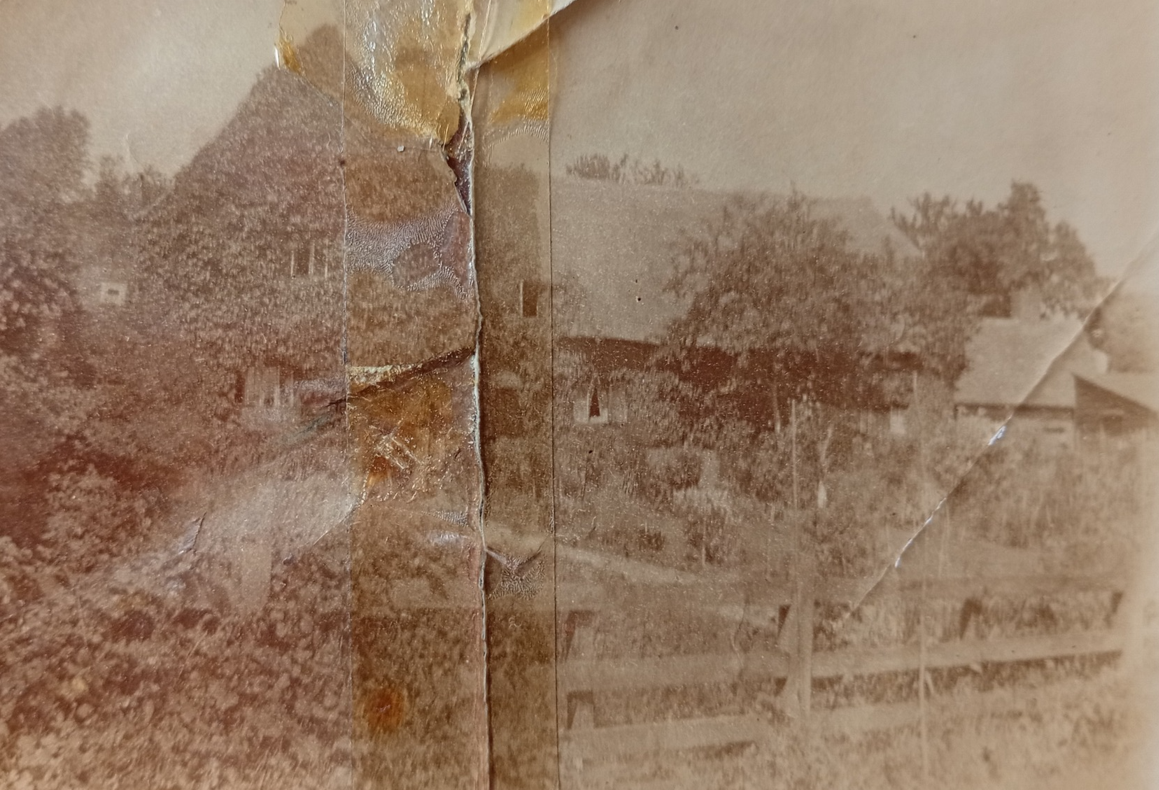
Undated but the earliest photo I have seen of Hill Farm
1926 saw the arrival of Henry Arthur and Vera Eliza Cook at Hill Farm. ‘Harry’, as he was known, was born at Norton in July 1897, the son of Arthur Joseph Cook and Mary Elizabeth nee Pope. The Cook family appear to have arrived at Norton from Boddington in the late 1870s and took over the tenancy of Court Farm. By 1901 Arthur had taken over the farm from his parents and Harry was there with a brother and two sisters. All were still in residence at Court Farm in 1911, about the time the following group photo was taken. Harry later saw army service in the First World War.
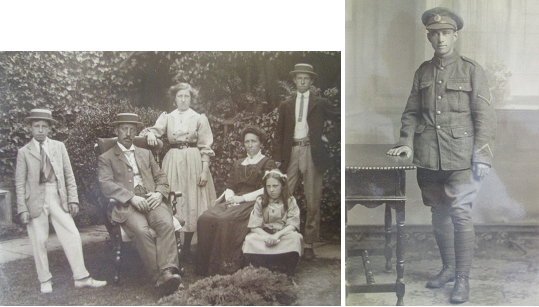
Harry, standing, to the left with his family at Court Farm and in uniform during WW1
In 1939 Harry was recorded as a farmer, stock breeder and senior air warden, and wife Vera a WVS air warden, and they were still at Hill Farm with their children. Harry left Hill Farm in 1948 when the couple took on Court Farm from his parents and Frederick H, Marjory L Cole and their daughter Denise moved here from 26 Tythe Cottages, at the bottom of the lane to Hill Farm.
It appears that Beatrice Mary Wheeler was also in residence from 1936 till she married in 1938. In 1928 Beatrice, whose parents Fred and Florence Wheeler lived at No30 Wainlode at this time, had an illegitimate son, Roydon, and this may have been the reason for her leaving home. It is assumed that Roy lived at Hill Farm with her in the 1930s but didnt join her when she married. Later Roy was living with relatives at Cold Elm until he was thrown out. Harry Cook spotted him sat on the side of the road with his belongings, picked him up, arranged accommodation for him with Tim Cole and family at Hill Farm and gave him a job at Court Farm.
In 2009 Denise Blanchard (nee Cole) shared her memories of the family’s time at Hill Farm; “I lived in the cottages at Hill Farm with my mother and father till I was about seven. Capt Norton Walker owned all the cottages, the houses and the farms. Harry Cook said to my father one day that he was moving to Court Farm to where his father had lived and his father then had passed away and Harry Cook was taking over Court Farm and Hill Farm would become empty. He said to my father, Tim, why don’t you go and try and see if you can rent it. So my father made an appointment to see Capt Norton Walker. I remember in this little old Austin 7 car we went down the drive to the manor house, my father took his cap off, stood at the door, and rang that big bell that echoed all the way up the corridor and he was shown in.
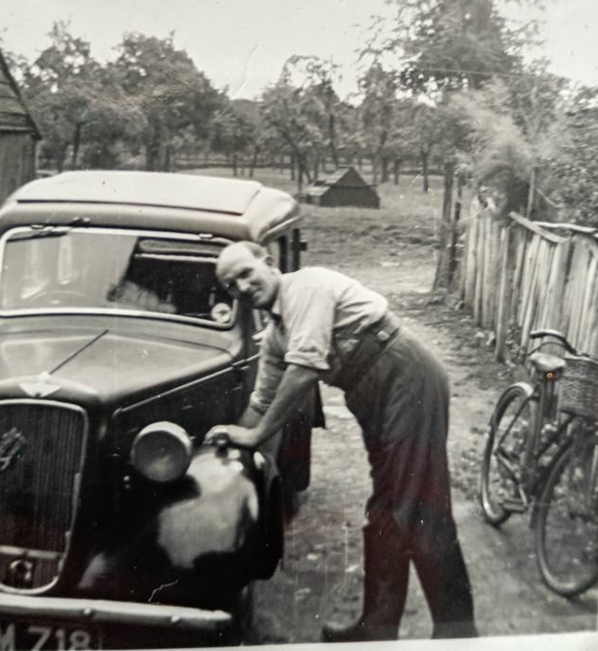
Tim Cole with his Austin 7 outside Hill Farm
He went to see the squire and Capt Norton Walker always referred to people by their surnames and never a ‘mister’ in front of it so it was just Cole, what do you want. My father said he wondered if he would consider him as a tenant for Hill Farm. He said come back in a week’s time and I’ll let you know. My father recalled it as being the longest week of his life and a week later went back to see Capt Norton Walker to be told he could rent Hill Farm.
So after moving Mr & Mrs Cook and the family down to Court Farm it was our turn to go to Hill Farm and I remember the day I went to school and my mother said if you come in from school and we’re not at the cottage, then you make your way up to the top of the drive and Hill Farm and you’ll see the horse and cart in the yard and we’ll be unloading furniture. And sure enough they were.
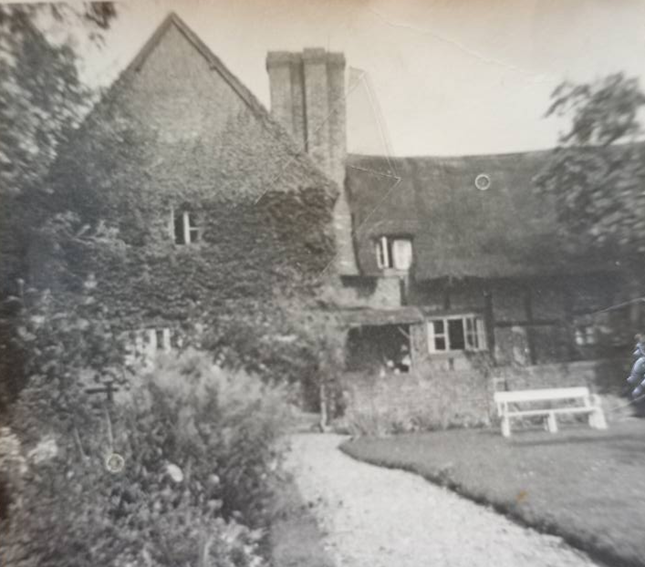
Hill Farm, 1948
I remember Hill Farm as being such a cold old farmhouse. The front door was like Norton Church door and the key was about the same size as the church key. It was just wattle and daub walls, flagstones and no heating. My father got a Calor gas cooker with the Calor gas bottles and you could guarantee that half way through cooking a meal a bottle would go and would have to be changed. Our only lighting was Tilley lamps and we had no water. We had a pump in the yard that would go dry in May. We’d have to fetch our water in churns from the old spring by the pump house. And then my father laid a plastic pipe along the top of the ground from the spring to our house but you could be sure that a cow would stand on the pipe and split it so we would have to go across and join it up. That’s the first memories I have of Hill Farm.
It was 15 acres of ground with Hill Farm and my father, first chance he had to get to market after moving in, he went and bought some milking cows and as I recall, my father was the only farmer that milked by hand as many cows as he did. My father milked about twelve cows each night and morning by hand.
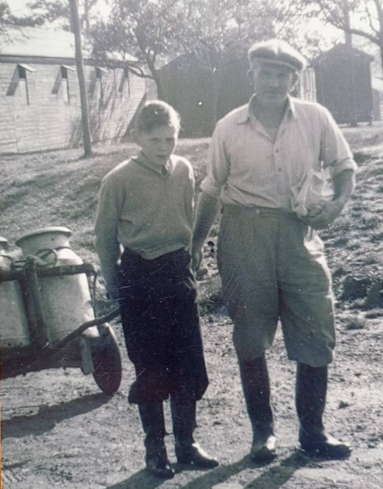
Tim Cole with the cart he used to deliver milk to Harry Cook at Court Farm as he didnt like having the lorry pull up his drive.
My father, from the years he had spent in the butchery world with the butcher that he worked for, my father became an extremely good butcher. He had the license in the village for the slaughtering of peoples animals. Most people who lived in the little cottages had a pig cot at the top of their garden and they would have a pig fattening up for their yearly supply of bacon. Also most of the farmers had pigs to be killed as well. My father would either go to their place if it was convenient or the animals would come to the farm. I always remember my father had a humane killer where he would shoot them and then they were put on a bale of straw to burn all the hair off then they would be hung up in the barn and all the insides taken out. My father would then cure the hams and bacon which took about six to eight weeks and then they were put to dry and the people who owned the pigs would come to collect them.
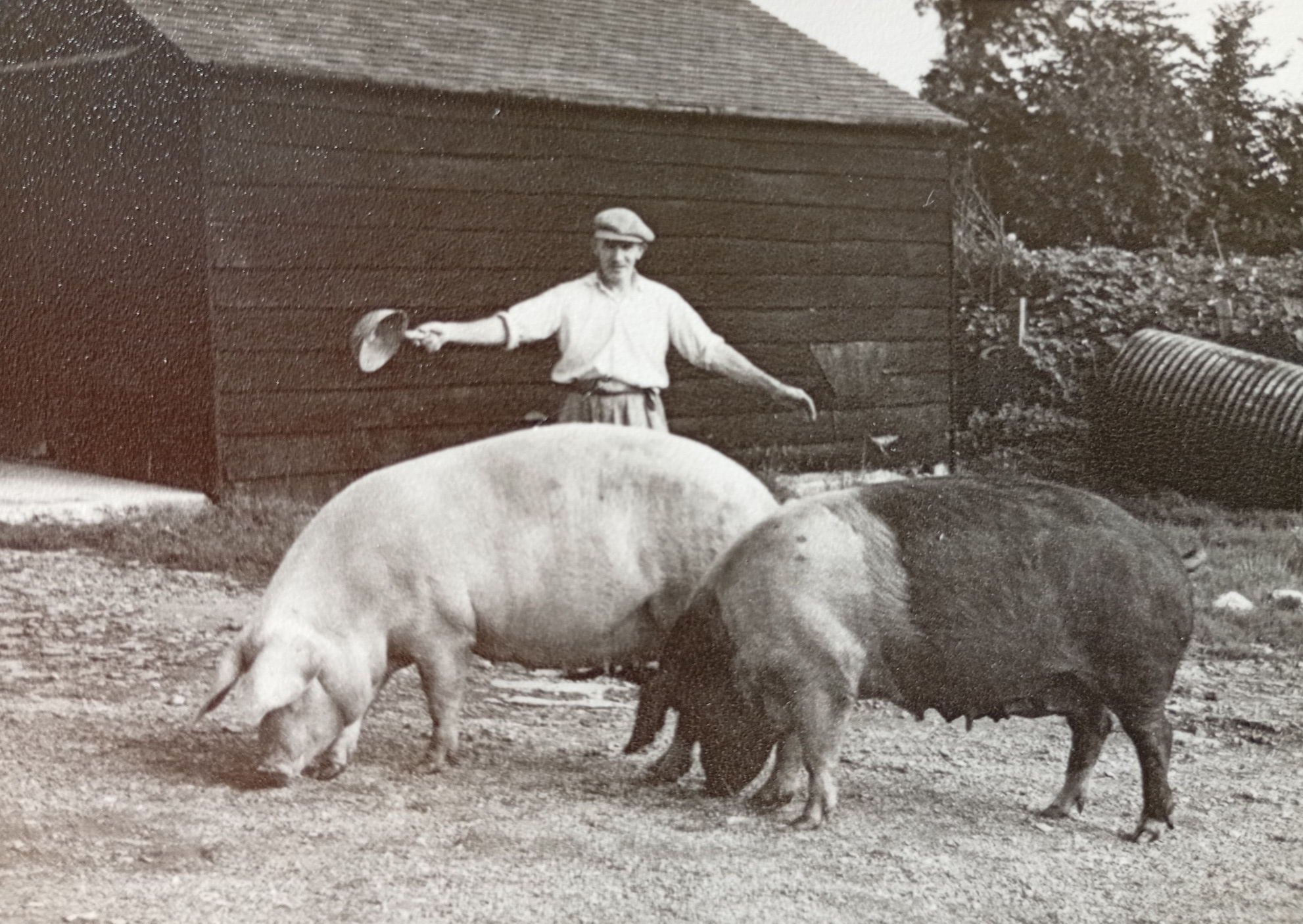
Tim Cole with a couple of pigs at Hill Farm
Apart from the 15 acres of land that went with Hill Farm, my father also helped Harry Cook with the land that went with Court Farm and my father would run a lot of sheep on some of the ground there and at lambing time we used to use the barn across from Hill Farm. Come out of the lane from Hill Farm and on the opposite side of the road on the next bend going down to Court Farm was a big yard with a building and lots of loose boxes that you could take care of the lambing of the sheep. At lambing time we used to use this yard and we used to tie sheaves of corn round to keep the bitter wind out and we used to put the sheep that were going to lamb that night into the pens and my father and me would take it in turns through the night to go down to keep an eye on them all. Quite often when we would have a lamb that was fostered onto another sheep we would have to put them in a loose box and try to get the mother to adopt them. I always used to take the collie dogs with me and a couple of bottles of milk in my pockets so that I could take care of the lambs that needed a drink. My father used to do exactly the same thing but we used to try and take it in turns because there were times when I wasn’t quite old enough to go and relieve my dad of the night shift and he would not get undressed and into bed for three weeks at a time when the lambing season was taking place. If we had a lamb that was born dead we would try to take a lamb from one of the ewes who had twins and foster this onto the other ewe so that she could have a lamb and they all would have a better chance with having just one lamb each. But the sheep were very sensitive and knew it wasn’t their lamb and either my father or I would take the skin off the dead lamb and carry it on the lamb that we were trying to foster and hope that she would take to it and sometimes it worked and sometimes it took a few more days. They have much better ideas now I believe, they have much simpler ideas, you don’t have to go to those lengths anymore.

Marjory Cole with daughter Denise and one of their sheep
We always had horses at Hill Farm. That was my father’s first love I would say and butchery his second. My father would break in horses for people so you never knew what horse was coming to stay next and you never knew which horse he would be riding out. I always had a pony of my own and I always rode the same pony but my dad you never knew what horse he was going to ride and if ever anyone had a problem with a horse they would come along and see if Tim could sort it out and he usually did.
Amongst all of the horses we used to have was Major who worked hard around the farm. We used to have a cider press that required the turning of a wooden bar to extract the juice from the apples and this was one of Major’s jobs. We harnessed him to the bar and he walked around and around. The only problem was that he needed someone to supervise him and make sure he didn’t stop and that became my job. Often I seemed to be doing this for hours thinking that everyone had forgotten about me. Major also used to pull the small cart that took us backwards and forwards to Gloucester for the markets. One day I was up in the woods on top of the hill and heard a lot of commotion at the farm. Hurrying down I found that Major had fallen into the pond and was stuck up to his shoulders in the mud. Everyone came to help pull him out and with the aid of a tractor we finally saved him. What with mechanisation you don’t get to see horses working on the local farms anymore these days.
We had lived at Hill Farm a very short time when Capt Norton Walker passed away and, as you know, the whole of Norton Estate was sold and at the auction the only two places that did not sell was Harry Cook’s place at Court Farm and Hill Farm".
The catalogue for the sale of the Norton Court Estate in 1952 described the farm as follows;
“A valuable freehold fruit growing and rearing farm situate on the west side of the lane leading from the village to Wainlode Hill. The farm comprises the desirable house, suitable buildings and enclosures of pasture and pasture orcharding extending to 12a 2r 39p.
The farmhouse is built of brick, half timbered, and has a partly thatched and partly tiled roof and contains;
On the ground floor: Porch, hall with cupboard under stairs, sitting room 20ft x 14ft, with beamed ceiling; dining room 17ft x 9ft, excluding recess with beamed ceiling; back hall off which are scullery and kitchen, larder and cupboard under stairs.
On the first floor: which is approached by two staircases are: Four bedrooms, two having fireplaces, bathroom with bath and basin (c) and wc.
Outside: Match-lined wash-house with furnace and fireplace, coal house, greenhouse, lawn and garden.
The Calor Gas installation is claimed by the Tenant. Water is obtained from a well adjoining the house.
The farm buildings comprise: A timber and galvanised meal house, two pigscotts, 4-tie cow house and loft, a lean-to timber and tiled box, brick, timber and tiled cider house, mill house (galvanised roof) with mill and press and 3-bay brick, timber and tiled shed and yard. (The brick, timber and galvanised barn is let with The Court Farm for storing implements).
The land comprises 9 acres of very good mixed orcharding and the pasture contains some excellent herbage.
Schedule
No on Description Quantity
Ord. map Acres
In the occupation of Mr F Cole
28 House and buildings … … … … .420
30 Pasture orchard … … … … 4.264
53 Pasture … … … … 2.727
Pt54 Pasture orchard … … … … 1,787
9.198
In hand
57 Pasture orchard … … … … 3.551
12.749
The house and buildings and about 9 acres are in the occupation of Mr F Cole on a Lady-Day tenancy at a rent of £100 per annum.
Returning to Denise Blanchard (nee Cole) memories of her family’s time at Hill Farm; “Brookes’ at Sandhurst bought Court Farm after the sale then that just left Hill Farm remaining and Mr Bruton rang my dad one day and called him into the office and said that Hill Farm is the only place that’s not been sold, we need to wind this estate up, can we come to some arrangement. And I remember my father coming back home and saying that he had agreed to buy Hill Farm. The money he’d made through butchery over his lifetime, my mother and father had managed to save £1000 which would be more like £100,000 today I would well imagine and they put £1000 down on Hill Farm and they mortgaged themselves for £600 so the actual price of Hill Farm was £1600. [In the catalogue for the sale of the Norton Court Estate in 1952 the farm was described as a fruit growing and rearing farm of 12 acres and it is recorded that it was bought by the tenant for £2600].
My father after buying Hill Farm went to a sale at Innsworth, some Nissan huts were being sold which were surplus to requirements following the war. My father bought two Nissan huts and brought them home and had them erected at Hill Farm. They then ran deep litter hens in them. The deep litter hens had to have so many hours light a day to lay the eggs that was required to make them profitable but of course there was no electricity. My mother and father would get up at 3 o’clock in the morning g and I can hear them pumping those Tilley lamps up in the kitchen and they would take them down and hang them on hooks in the chicken houses to get the chickens up and feeding to get the production of eggs that was required. He eventually got an electric line laid in. It came up across the orchard at the bottom, the bottom orchard, it came up by where the red brick wall is, and came up across the orchard and into the house. And the next thing, one day we had electricity and my mother had a timing switch where she could set the timing clocks for the lights to come on to feed the chickens and my mother and father didn’t have to get up at that unearthly hour in the mornings.
We also did a lot of Christmas poultry. Monica Cook and I used to be kept home from school two weeks prior to Christmas to pick the Christmas poultry and we used to sit in the old shed with hessian sacks over us and we’d pick away all day and my mother would do the dressing of the birds and my dad would always pick the geese in the orchard, standing up down in the orchard in the cold. We used to sit on chairs and have a nice old log fire going and sit there all day picking these chickens. Off course, as I’ve said, Hill Farm was a very, very cold house so the birds used to keep and of course the winters seemed to be colder then and the big room in Hill Farm, we eventually turned into the bar place, we would take all the carpets up and we would lay newspaper down on the whole floor and they would be laid out with all the Christmas birds with peoples orders with their names on them and they used to come and collect them for Christmas.
The only social activity I ever remember enjoying at the farm was going fox hunting with my father, maybe twice a week, and that was the one pleasure that we had together, really enjoyed. My mother never did ride horses".
Breaking from Denise's memories briefly, on another occasion she told me the following story and gave me this photo taken at Norton Church in 1954 at a neighbour's wedding;
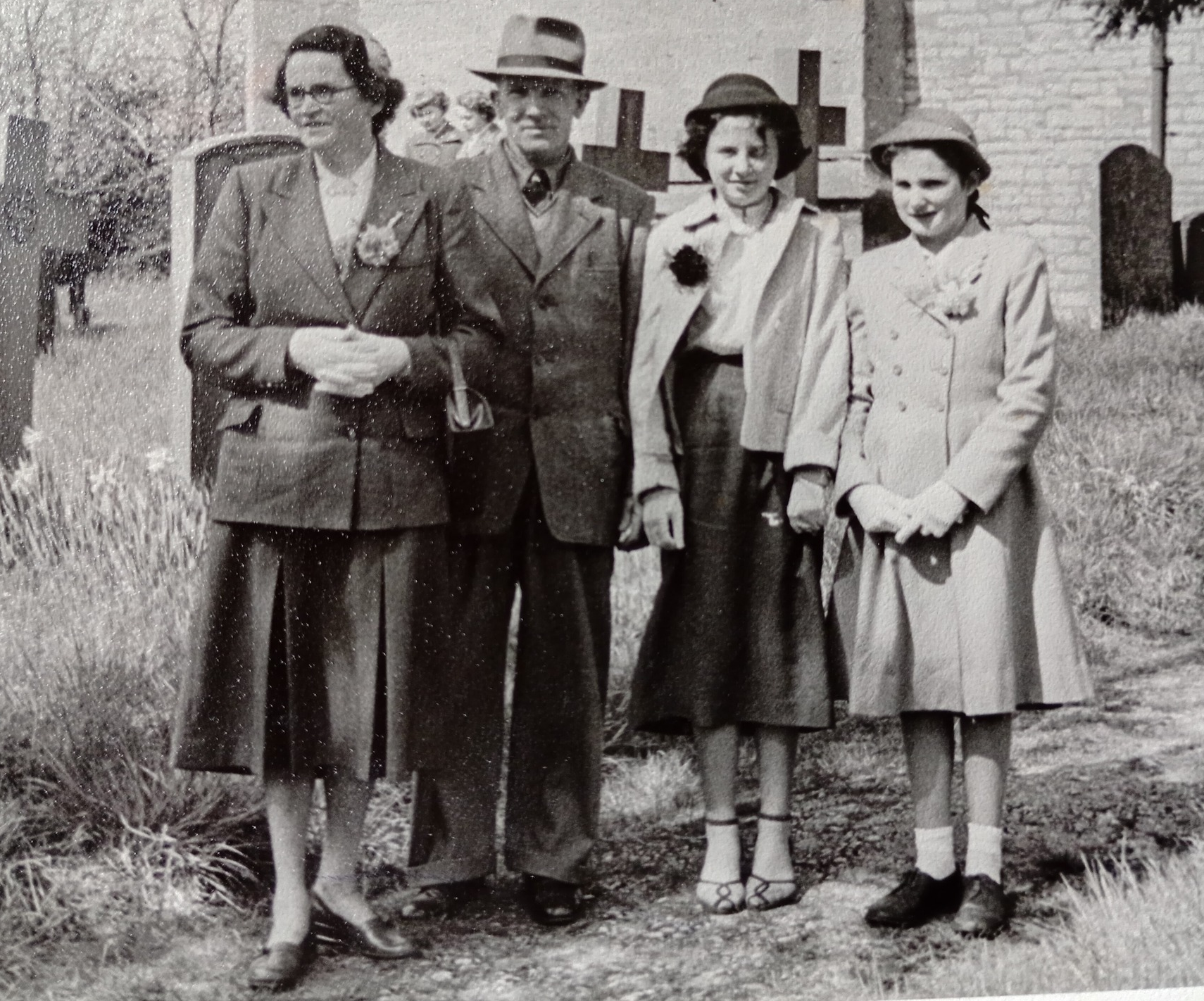
"That is my mum and dad, that’s me, and that’s Joyce. The story of that is dad was at the farm one day after the war and this gentleman came up on his pushbike, he was Polish. Dad would buy anything and he used to work at Innsworth Camp during the war, he was a stoker on the boilers there, and that’s how he came by a big container like box and it was all insulated and there was all cables in there, and dad said it had been used in the war. Anyway, it ended up at the top of our paddock at the back of the house. Anyway, this man said they were desperate for somewhere to live and could he have it to live in. Dad said you can’t live in that. He said but yes I could build another room onto it and he did with timber and he built an extension onto it, built a wooden like chalet, and a porch and everything, it was lovely. They lived there for some years. Their name was Teszner. His wife was English, I think she had quite a good job, she used to go off to work every morning, and he would spend time building that place there. Their daughter used to go to Gloucester to school, I can’t remember her ever going to Norton school. Then they moved into Gloucester and we lost touch with them. My first husband worked at Castle Meads Power Station and he worked with a man who was married to Joyce, Turner I think their name was. And that’s the last I heard anything of them”.
The electoral roll for Norton from 1954 confirms that the couple in question were Sergjusz and Mary F Teszner and that they were living in a house on the hill at Hill Farm.
Sergjusz was born on 6 June 1894 at Strzelno, Poland, the son of Michel Teszner and Maria nee Picheau. At the start of the Second World War, Sergjusz served in the Polish Air Force, rank St.Szeregowiec, General Duties (Clerk). With the fall of Poland he came to England and served through the remainder of the war, 1940-47, as Aircraftsman 1st Class, No 783906, in the Royal Air Force. Mary F Teszner was born Mary (Marie/Maria) Frances Niblett on 4 January 1909 at Edinburgh, daughter of Albert Edward Niblett and Florence nee O’Donnell. Albert had married Florence O’Donnell on 23 August 1906 at the Sacred Heart of Jesus Church, Lauriston, Edinburgh, and daughter Marie Frances was baptised here whilst they were living at 12 Keir Street, Edinburgh. Later Mary Niblett spent time in mainland Europe with her parents and paternal grandparents. In 1939 Mary Niblett was living at 153 Castle Boulevard, Edinburgh, employed as a French copy typist, and held an auxiliary first aid role. At the same time her paternal grandparents, Albert Snr and Marie Niblett, were living at 9 Dragon Road, Harrogate, Yorks, where Albert was incapacitated and Marie was a State Registered Nurse. Joyce Teszner appears to have been the illegitimate daughter of Mary Frances Niblett, born in 1941 in Lancashire, although it is possible that Sergjusz was the father as Mary must have met him by this time. In May 1943 Mary legally renounced the surname of Niblett by deed poll and assumed the surname of Teszner. On 1 August 1946 the family were living at Laston Guest House, Hillsboro Road, Ilfracombe, Devon, when they advertised in the The North Devon Journal – Herald newspaper; “Wtd. Unfurn, House, Flat or Cottage, Barnstaple district, 2 adults, 1 child, perm. – Teszner”. By 1948 Sergjusz and Mary were living at 9 Dragon Road, Harrogate, along with an Elizabeth Niblett and several others. In early 1949 Sergjusz Teszner married Mary Niblett/Teszner at Nottingham and on 9 July 1948 he became a naturalised British subject. By 1953 the family had come to Norton and their daughter Joyce attended Central Technical School for Girls, Gloucester. By 1959 the Teszners had left Hill Farm and were living at the White House, Wigpool, Mitcheldean. Daughter Joyce married Albert Turner at Ross in 1961 and they had three daughters; Kathleen, Helen and Frances. In 1961 Sergjusz and Mary were living at 13 Westend Parade, Pool Meadow, Gloucester, and were still here when Sergjusz died on 4 May 1967 and when Mary died on 2 June 1996. They have a memorial at Coney Hill Cemetery, Gloucester.
Returning to Denise Blanchard's memories of her years at Hill Farm; "In the latter years of my father’s life, financially he found it a little difficult to make ends meet out of the farm as things had become more streamlined and just out of 15 acres it wasn’t possible to make a good living so my mother started taking in bed & breakfast people and she advertised in a holiday book for farm holidays and my mother used to do bed & breakfast and evening meal and people would come back year after year. Their children would enjoy helping my father around the farm, feed the pigs, collect the eggs, feed the ducks, geese, and get the cows in for milking. Of course people didn’t worry quite so much then, there wasn’t the health and safety restrictions that there are today to let children enjoy this. There was always a lot of fruit to be collected as well.
In January 1963 my father became ill with a stroke and in the May he suffered another stroke and passed away at the age of 58. That was the terrible winter of ’63, it started snowing on Boxing Day and snowed all the way through. The water pipes up the stairs were frozen solid so we couldn’t get any water up to the toilet and it was bitter, bitter cold.
My mother passed away the following year, 18 months after my father, at the age of 61. After the death of both my parents then the divorce of my first husband I had to try once again to make Hill Farm pay. I opened up a tea room, I had a couple of lodgers, I did bed & breakfast and evening meals, I rented all my ground out to farmers, so I could get some income from that cause I didn’t have any other income coming in. I had no maintenance support for my two children so I decided to do all those things to help it pay and we struggled by. We used to pick the fruit out the orchard and sell them, plums for sale. Then one day Mr Ibbertson, Ken Ibbertson, from Longlevens School, who was one of my son’s teachers, rang me and said would I be interested in doing a lunch for his mother for her birthday as she didn’t want to go to a restaurant or a pub and so Barbara and I started doing it. Barbara Ainge and myself and we worked out a menu and a price and we did our first dinner party, well lunch party, it was a Sunday lunch. It went off extremely well, it was very successful and I had numerous phone calls from school afterwards asking me if I would do a party for them and that’s how it started. I never advertised my parties once and by the time I retired I was averaging one every other day. Obviously people wanted to drink with their meal and I used to make a lot of homemade wines; elderflower, elderberry, dandelion – you name it, I made it. I used to sell carafes of wine with the meals, reds and whites, and then I got a tip off that I was being reported to the licensed victuallers for not having a license so in desperation I rang my solicitor and he said, I had a marvellous solicitor, he was always so quick thinking, he said increase the price of your meal, tell your party guests what you are doing, and that it includes the wine and that you’ll make it as a gift. So we got away with that for quite a while and I gave the parties making a gift of the wine. Then people wanted to bring along casks of beer and bottles of spirits and they wouldn’t go home and we couldn’t get locked up and they had too much to drink. So with a new man coming into my life, who turned out to be my second husband Arnie, we converted my dad’s cowshed into en-suite bedrooms and a breakfast room and we decided to apply for a license, an alcohol license, for Hill Farm".
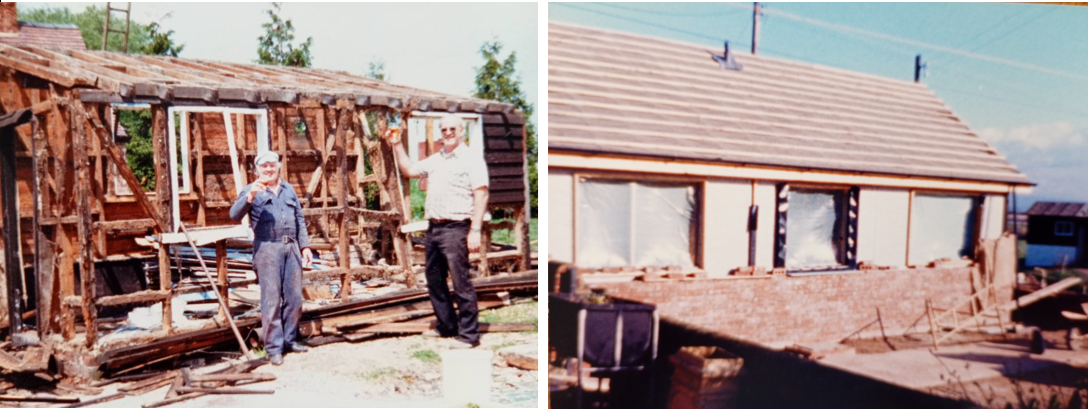
This is the Notice of application for provisional grant of a justices’ licence, Licensing Act 1964; "To whom it may concern. I, Denise Elaine Carr, now residing at Hill Farm Guest House, Norton, Gloucestershire, having during the past six months carried on the trade or calling of private caterer and being a person interested in the premises described below, do hereby give notice that it is my intention to apply at the transfer sessions for the said district to be held at Gloucester Magistrates’ Court on the 26th day of August next, for the provisional grant to me of a justices’ licence, authorising me to sell intoxicating liquor of all descriptions for consumption on the premises about to be altered or extended for the purposes of being used as a house for the sale of intoxicating liquor situated at Norton in Gloucestershire and to be known as ‘Hill Farm Guest House’ of which premises I am the owner and it is my intention to apply to the justices to insert in such justices’ licence the conditions required for it to be granted as a residential and restaurant licence. Dated the 7th day of August 1987”.
Continuing with Denise's memories; "We got a license passed through the courts and my husband built a beautiful bar and we were able to control the amount of alcohol that people had. We were the first people to get an alcohol license to Hill Farm. It was only a restaurant license but it gave us the control over the amount of drink that people had and we ran that for about six years until my husband had a massive heart attack on the Christmas week and passed away and I tried very hard to run it. That was in ’92 and I ran Hill Farm until ’99 but my health failed and I was just trying to do too much. It wasn’t possible for me to be able to keep it going. So I was able to sell Hill Farm”.
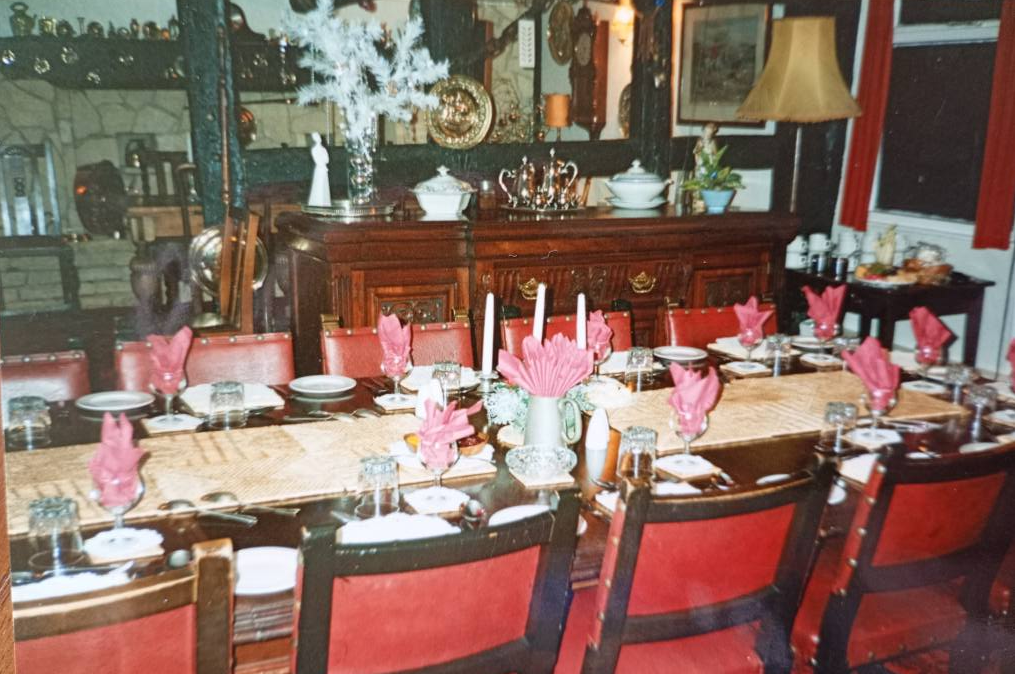
Was marketed by Humberts of Cheltenham, in April 1993 at £350,000; "There is believed to have been a house on this site since the Domesday Book but the main original part is understood to date back to the time of Henry V and then in the twentieth century additions were made very much in keeping with the original and there is now provided a detached house of character facing south east over its own garden and paddock and it is listed as being of special architectural interest, listed grade II, and is built of brick and exposed timber work under thatched or tiled roof" ... "a detached listed period country house of character currently used as a successful restaurant plus five letting bedrooms and owners accommodation, the whole standing in a lovely position within its own ten acres. Entrance hall, lounge bar, superb dining room in two sections, well fitted modern fitted kitchen plus separate cooking and food preparation rooms, sitting room, residents dining room, utility room, 2 ground floor bedroom suites, 4 first floor bedrooms, bathroom, shower room, 2 separate washrooms, delightful second floor owners sitting room. The whole about 10 acres".
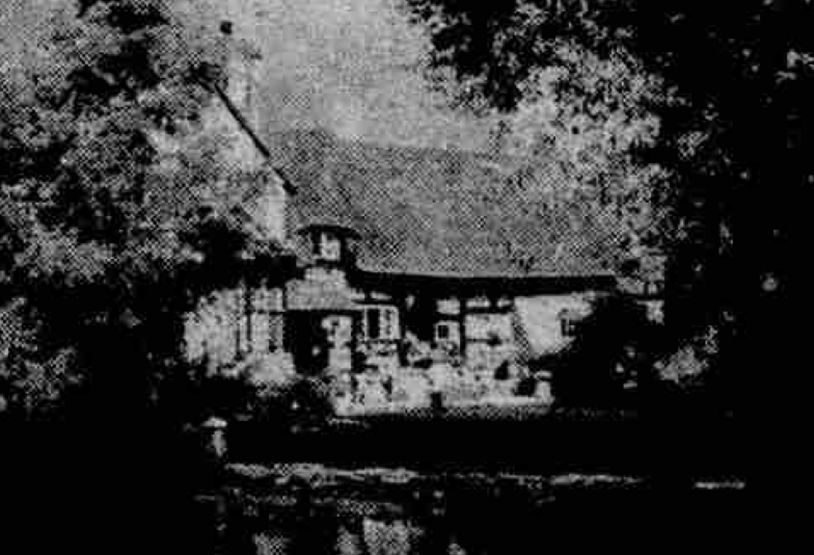
[April 1993]
In 2002 Nicholas J and Richenda G Hine were here.
Hill Farm is a grade II listed building described as a former farmhouse of late 17th to early 18century date, now a house, known as Hill Farm, Bishop's Norton. The listing records; “Former farmhouse now house. Late C17, early C18, C19. Brick and square-panelled timber-framing with unpainted brick infill, red tile roof and thatch with decorative ridge. Late C17-early C18 brick block with almost square plan left, timber-framed and brick extension set back on right with C19 brick extension onto right gable-end. Brick block left with gable facing front; 2½ storeys. C20 two-light casement lighting ground floor, 3-light window to first floor with original soldier-arched head, single light C20 window right, large 2-light C20 casement with glazing bars lighting garret, bands between storeys. C20 part-glazed door up C20 steps right. Timber-framed block; 1½ storeys, single eyebrow dormer left with 2-light casement. Single light and 2-light casements with and without horizontal glazing bars lighting ground floor. Brick buttress right. Single storey C19 extension; C19 plank door and casement window. Massive composite stack at junction of brick and timber-framed parts. Right-hand end of timber-framed part, hipped”.
